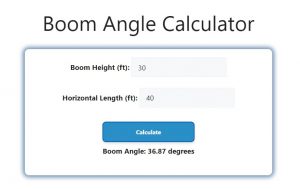About Boom Angle Calculator (Formula)
The Boom Angle Calculator is an essential tool for professionals in construction, engineering, and logistics, helping them determine the angle at which a boom operates. Understanding the boom angle is crucial for ensuring safety and efficiency during lifting operations. By accurately calculating this angle, operators can optimize the use of cranes and other equipment, minimizing risks and improving operational performance.
Formula
The formula to calculate the boom angle is:
Boom Angle = arctan(Boom Height / Horizontal Length)
Where:
- Boom Height is the vertical distance from the base of the boom to its highest point.
- Horizontal Length is the distance from the base of the boom to the point directly below its highest point.
How to Use
- Measure the Boom Height: Determine the vertical distance from the base of the boom to its peak. This can typically be measured with a tape measure or similar tool.
- Measure the Horizontal Length: Measure the distance from the base of the boom to the point directly beneath its highest point, ensuring the measurement is taken horizontally.
- Apply the Formula: Substitute the measured values into the formula.
- Calculate the Boom Angle: Use a scientific calculator or trigonometric tables to find the arctangent (inverse tangent) of the ratio of boom height to horizontal length.
Example
To illustrate how to calculate the boom angle, let’s consider an example.
- Given Data:
- Boom Height = 30 feet
- Horizontal Length = 40 feet
Step 1: Apply the Formula
Boom Angle = arctan(Boom Height / Horizontal Length)
= arctan(30 / 40)
Step 2: Complete the Calculation
Using a scientific calculator:
Boom Angle = arctan(0.75) ≈ 36.87 degrees
In this example, the calculated boom angle is approximately 36.87 degrees.

FAQs
- What is a boom angle?
The boom angle is the angle between the boom and the horizontal ground, indicating how elevated the boom is. - Why is the boom angle important?
The boom angle is critical for ensuring safe lifting operations and maintaining the stability of cranes and equipment. - How can I measure boom height accurately?
Boom height can be measured using a tape measure or a laser distance measurer for more precision. - What tools can I use to calculate the boom angle?
You can use scientific calculators, trigonometric tables, or specialized software designed for construction and engineering. - Does the boom angle change during operation?
Yes, the boom angle can change as the load is lifted or as the boom extends or retracts. - What happens if the boom angle is too steep?
A steep boom angle can lead to instability, increased risk of tipping, and potential accidents. - Can I use the boom angle calculator for different types of booms?
Yes, the calculator can be applied to various types of booms used in cranes, excavators, and other lifting equipment. - What is the maximum safe boom angle?
The maximum safe boom angle depends on the equipment and the manufacturer’s guidelines. Always refer to these specifications. - How can I ensure safe lifting operations?
Always calculate the boom angle, follow safety protocols, and ensure the load is within the equipment’s rated capacity. - Is it necessary to re-calculate the boom angle after adjustments?
Yes, it is essential to recalculate the boom angle after any adjustments to the boom height or horizontal length. - What should I do if I don’t have measuring tools?
In the absence of measuring tools, use estimations, but keep in mind that this can lead to inaccuracies. - Can weather conditions affect the boom angle?
Weather conditions can affect the lifting operation’s safety but do not change the calculated boom angle itself. - How do I interpret the boom angle in relation to lifting capacity?
A larger boom angle typically reduces the lifting capacity of the crane; always refer to load charts provided by manufacturers. - Is training required to operate cranes safely?
Yes, proper training and certification are necessary for safe crane operation, including understanding boom angles. - What is the relationship between boom angle and load stability?
A correct boom angle helps maintain load stability, while incorrect angles can lead to tipping or load swings. - How can I improve my understanding of boom angles?
Consider taking courses or workshops focused on crane operations and safety protocols. - Can the boom angle be adjusted during operation?
Some cranes allow adjustments to the boom angle during operation, while others require it to be set before lifting. - What safety precautions should I take when calculating boom angles?
Ensure the area is clear of obstacles, and never exceed the equipment’s rated capacity. - Do all cranes use the same boom angle calculation?
While the fundamental concept remains the same, specific calculations may vary based on the type of crane and its design. - How often should I calculate boom angles?
Calculating boom angles should be done every time the equipment is set up for a new lifting operation.
Conclusion
The Boom Angle Calculator is a crucial tool for ensuring the safety and efficiency of lifting operations in construction and engineering. By accurately calculating the boom angle, operators can make informed decisions about load handling and equipment use. Whether you are a seasoned professional or new to the industry, understanding and applying the concept of boom angles will enhance operational safety and effectiveness. Always prioritize safety by adhering to guidelines and manufacturer recommendations when calculating and adjusting boom angles.